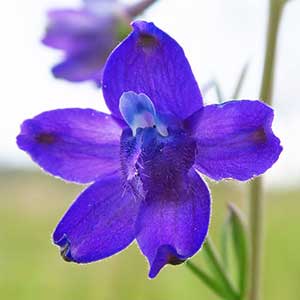Delphinium nuttallii subsp. nuttallii
(synonym of Delphinium oreganum)
Delphinium stachydeum
Willamette Valley larkspur
hedgenettle larkspur, Rocky Mountain larkspur, spike larkspur, Umatilla larkspur
40-70 cm.
(40-)70-150(-200) cm;
base reddish, puberulent.
blade light green, ± round, 2-8 × 3.5-11 cm, sparsely pubescent; ultimate lobes 7-19, width 1-8 mm, apex tapering to point;
veins obscure.
(14-)30-60(-102)-flowered, dense, cylindric;
pedicel spreading, 0.8-2(-3) cm, puberulent;
bracteoles 1-4 mm from flowers, green, linear, 2-7(-10) mm, puberulent.
sepals blue or bluish purple, spurs 10-13 mm;
lower petal blades 4.5-6.5 mm.
sepals bright blue, puberulent, lateral sepals spreading, 9-13 × 4-7 mm, spurs straight, within 30° above or below horizontal, 11-17 mm;
lower petal blades ± covering stamens, 4-8 mm, clefts 0.5-2 mm;
hairs sparse, centered, mostly near junction of blade and claw above base of cleft, white.
10-15 mm, 3.5-4.5 times longer than wide, puberulent.
wing-margined;
seed coat cells with margins straight, surfaces ± roughened.
= 16.
Delphinium nuttallii subsp. nuttallii
Delphinium stachydeum
Populations of Delphinium stachydeum are widely scattered in isolated mountain ranges surrounded by desert or grassland. The species has been reported (visual sightings) from northwestern Utah; no specimens have been seen from there. Hybrids between D. stachydeum and D. glaucum have been reported. Although D. stachydeum has been seen flowering within 30 m of flowering D. depauperatum, no hybrids have been observed.
Delphinium stachydeum may possibly be confused with D. geyeri, from which it may be distinguished by its usually greater plant size, less pubescent foliage, and later flowering date. Delphinium stachydeum also may be confused with D. glaucum; see discussion under that species.
(Discussion copyrighted by Flora of North America; reprinted with permission.)
- Local floras:
CA,
OR,
WA
- Local Web sites:
CalFlora,
CalPhotos,
Flora NW,
PNW Herbaria
WildflowerSearch
iNaturalist (observations)
USDA Plants Database
- LBJ Wildflower Center
- SEINet
- Plants of the World Online
- Encyclopedia of Life
- Wikipedia
- Google Image Search


